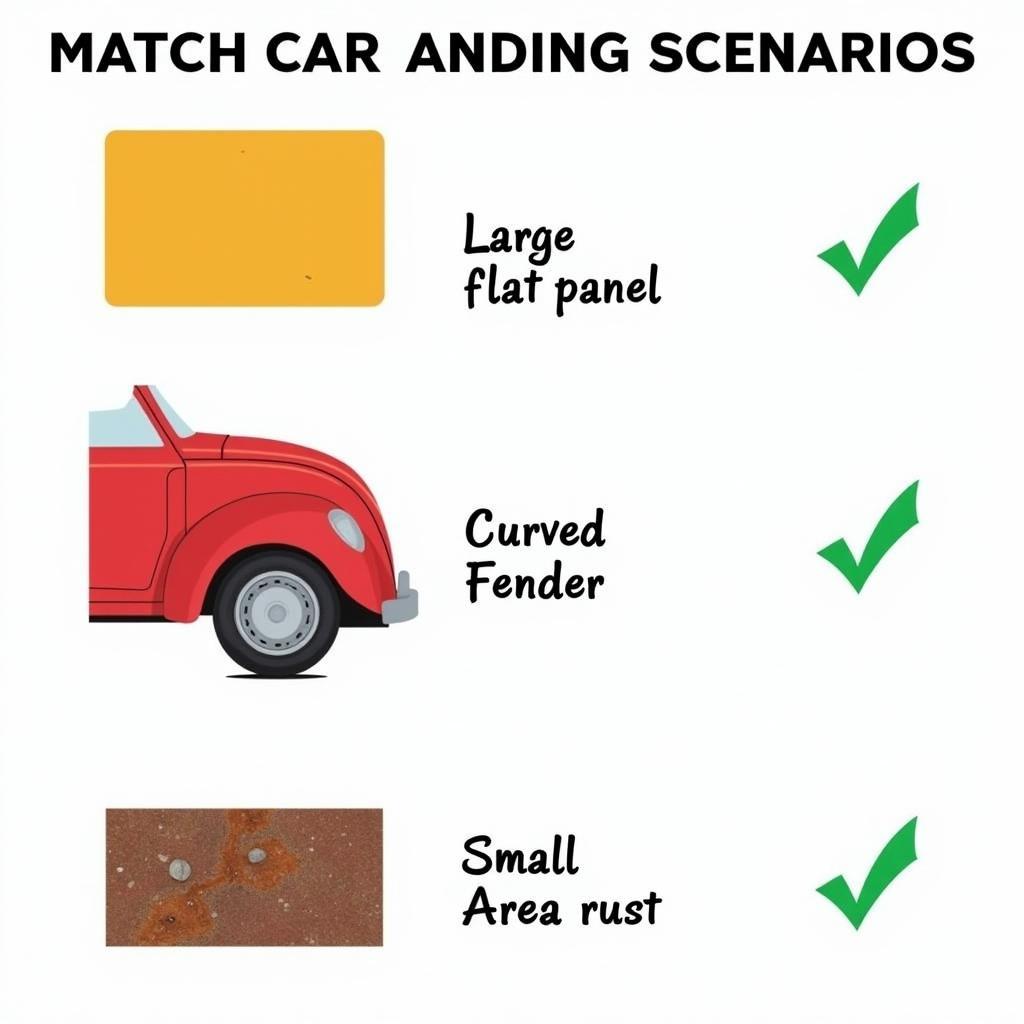Car Sanding Tools are essential for achieving a flawless finish in auto body repair and restoration. Whether you’re a seasoned professional or a DIY enthusiast, understanding the different types of car sanding tools, their uses, and proper techniques is crucial for achieving professional-quality results. This guide will delve into the world of car sanding tools, providing valuable insights and expert advice to help you make informed decisions and achieve a perfect finish every time.
Types of Car Sanding Tools
 Various Types of Car Sanding Tools for Auto Body Repair
Various Types of Car Sanding Tools for Auto Body Repair
Car sanding tools come in various forms, each designed for specific tasks and stages of the sanding process. Choosing the right tool is critical for efficiency and achieving the desired finish. Here’s a breakdown of the most common car sanding tools:
- Electric Sanders: These power tools significantly speed up the sanding process, especially for larger areas. They come in different types, including orbital sanders, random orbital sanders, and belt sanders. Orbital sanders are ideal for removing paint and smoothing surfaces, while random orbital sanders provide a swirl-free finish, perfect for final sanding before painting. Belt sanders are more aggressive and are best suited for heavy-duty sanding tasks. Check out our recommendations for the best tool for sanding car.
- Sanding Blocks: These hand tools offer greater control and precision, particularly for smaller areas or curved surfaces. Sanding blocks provide a flat, even surface for the sandpaper, preventing uneven sanding and ensuring a consistent finish.
- Sandpaper Sheets: Available in various grits, sandpaper sheets are the abrasive material used with both electric sanders and sanding blocks. The grit number indicates the coarseness of the sandpaper, with lower numbers representing coarser grits for heavy material removal and higher numbers representing finer grits for smoothing and polishing.
- Specialty Sanding Tools: These include tools like sanding sponges, contour sanders, and longboards, designed for specific tasks like sanding complex shapes or reaching tight spaces. Explore our article on car panel sanding tools to learn more.
Choosing the Right Car Sanding Tool
Selecting the appropriate car sanding tool depends on several factors, including the size and shape of the area being sanded, the type of material being sanded, and the desired finish.
How to Choose a Sander for Your Car
 Selecting the Appropriate Sander Based on Project Needs
Selecting the Appropriate Sander Based on Project Needs
“Choosing the right sander is crucial for efficiency and achieving a flawless result. Consider the scope of your project and the material you’re working with before making a decision,” advises John Miller, a seasoned auto body technician with over 20 years of experience.
- For large, flat areas: An electric sander, such as an orbital or random orbital sander, is the most efficient choice.
- For curved surfaces or intricate details: A sanding block or specialty sanding tool, like a contour sander, provides better control and precision.
- For removing heavy rust or old paint: A coarser grit sandpaper and a more powerful sander, like a belt sander, may be necessary.
- For final sanding before painting: A finer grit sandpaper and a random orbital sander are essential for achieving a smooth, swirl-free finish. Learn more about car sanding tools here.
Sanding Techniques for a Perfect Finish
 Proper Techniques for Sanding a Car for a Flawless Finish
Proper Techniques for Sanding a Car for a Flawless Finish
Proper sanding techniques are just as important as choosing the right tools. Here are some tips for achieving a professional-quality finish:
- Start with a coarser grit and gradually move to finer grits: This ensures efficient material removal and a smooth final finish.
- Use even pressure and overlapping strokes: This prevents uneven sanding and swirl marks.
- Sand in the direction of the grain: This minimizes scratches and ensures a more uniform finish.
- Clean the surface regularly: This removes dust and debris, allowing you to assess your progress and prevent clogging the sandpaper.
“Patience and attention to detail are key to achieving a truly professional finish,” adds Maria Sanchez, an expert in automotive paint and bodywork. “Don’t rush the process, and always double-check your work before moving on to the next step.”
Conclusion
Mastering car sanding tools and techniques is essential for anyone involved in auto body repair or restoration. By understanding the different types of tools available, choosing the right tool for the job, and employing proper sanding techniques, you can achieve a flawless finish that enhances the appearance and value of any vehicle. For more information on specific tools for removing clear coat, check out our guide on tool for sanding down clear coat on a car. Remember to select the best sanding tool for car for your specific project needs.
FAQ
- What grit sandpaper should I start with for car sanding?
- What is the difference between an orbital sander and a random orbital sander?
- How do I prevent swirl marks when sanding a car?
- What are the best car sanding tools for beginners?
- How often should I replace my sandpaper?
- What is the best way to clean a car after sanding?
- How can I tell when I’ve sanded enough?
Need further assistance? Contact us via WhatsApp: +1(641)206-8880, Email: [email protected] or visit us at 910 Cedar Lane, Chicago, IL 60605, USA. We have a 24/7 customer service team.

Leave a Reply